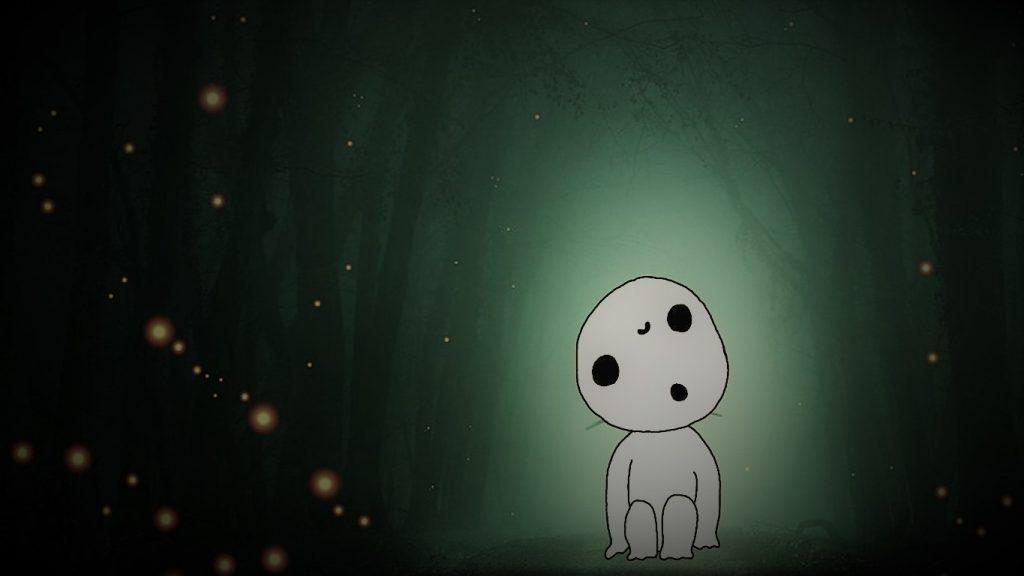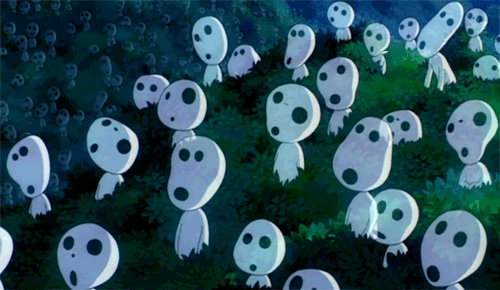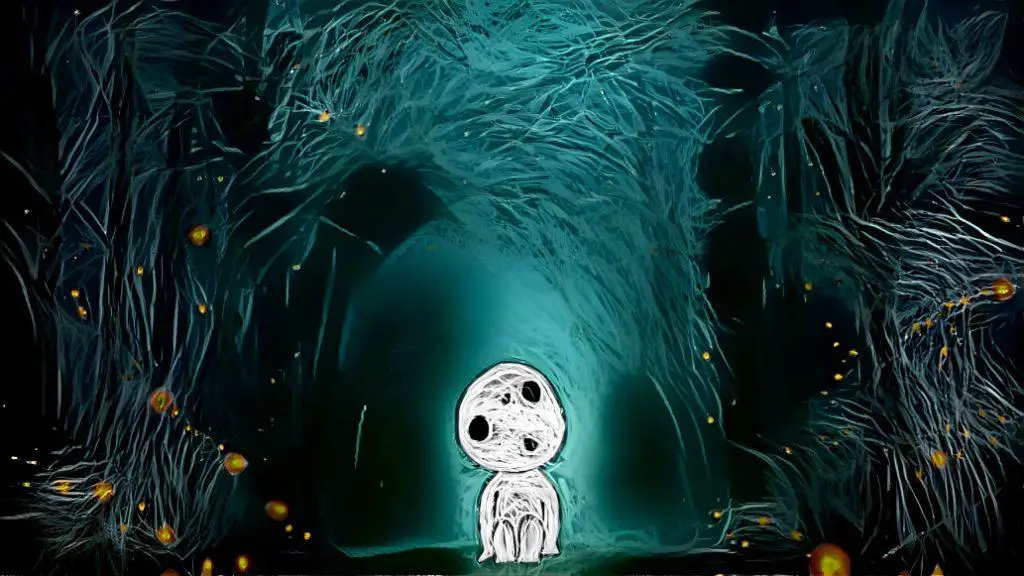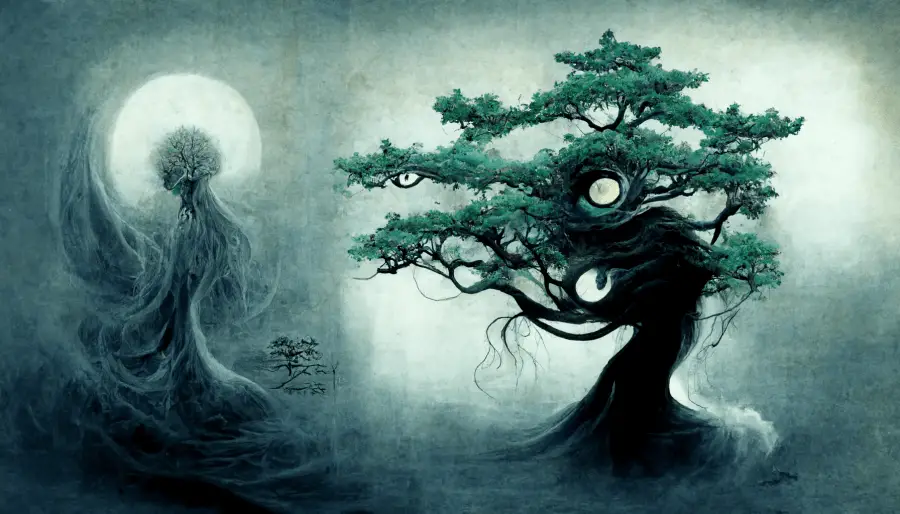Share the Lore!
By: Alex Postrado
The Ancient, Dryad-like Creatures Of Japanese Mythology
“If a tree falls in a forest and no one is around to hear it, does it make a sound?“
This age-old philosophical question has been the topic of discourse and the culprit for confusion for as long as anyone can remember.
Some say that there cannot be sound if there is no one to perceive it, while others argue that one thing does not become fictitious just because it went unnoticed.
And since there is no surefire way to get everyone on the same team when it comes to debates like this, it 一 perhaps 一 would be more interesting to talk about the proverbial sound instead.
What do you call the noise made when a tree collapses? How about the echoes resonating from it?
In Japanese folklore, both of those are directly associated with Kodama.
The tree-residing spirits, present in Japanese lore since ancient times, and going by various names depending on the form.
From gods turned nature deities, to the actual echoes from trees crashing down 一 here goes the resounding myth of Kodama.

What are Kodama?
Deep within the untouched forests of Japan, great trees of varying species are believed to be linked to Kodama 一 which are spirits that are said to reside within them.
Tales going as far back as 931–938 CE tells of the existence of these spirits 一 a reason why Kodama have been so deeply rooted in the minds of Japanese people, especially the older generation.
And as time passes, the term Kodama has been used as an umbrella term that typically pertains to three different yet related things:
The first are the spirits said to live in certain trees in a forest.
Revered by locals and sometimes even referred to as mountain gods 一 the existence of Kodama, in this sense, is said to be intertwined with the trees they inhabit.
Interestingly enough, the trees that serve as the dwelling of Kodama are also referred to as Kodama.
And as for the sound produced whenever a tree inhabited by Kodama falls down or is uprooted — well, it, too, is sometimes called Kodama.
Especially, when the noise one hears echoing throughout the forest and mountains arrives a little behind the timing.
And while Kodama can be heard, it is said that they are very rarely seen.
Of the few, conflicting accounts that describe their appearance, at least one state that Kodama takes the form of 一 either 一 atmospheric lights, humans, and sometimes even beasts!
In ancient legends, it is believed that they are invisible or have a “tree form” that is identical to that of regular trees.
Other accounts also tell of the romantic ventures of Kodama 一 where they are depicted as spirits that take on human form to be with their mortal lovers.
In illustrated works 一 such as that of Toriyama Sekien’s The Illustrated Night Parade of a Hundred Demons 一 Kodama has been depicted as an old man or woman standing nearby a tree.
The film Mononoke Hime or Princess Mononoke portrayed Kodama as “dual-color bobble-headed spirits“.

These widely varying interpretations of how Kodama looks only signify that this end of the Kodama lore remains open-ended for anyone to explore.
An aspect of the story that was also brought into question during the Edo period in Japan, when Kodama 一 back then revered as gods 一 was stripped of its ranks and were only presented as part of the omnipresent yōkai.
Other known yōkai include kijimuna 一 which are “small wood spirits” that are native to the island of Okinawa.
Incidentally, kijimuna is a type of kiinushii 一 which are tree spirits that resemble Kodama in more than a few ways.
When trees are cut down, it is encouraged to pray to kiinushii beforehand.
Moreover, it is said that if one hears the sound of a fallen tree at night when there are actually no fallen trees, it is the kiinushii expressing its anguish for the impending withering of a particular tree nearby.
The Link Between Kodama and Trees
Despite varying accounts written and told about Kodama, one thing is clear about them.
Kodama are not only said to be connected to the trees they inhabit, but the link between them also runs as deep as their life force.
According to the lore, the tree and the spirit share the same life 一 which means, if the tree is to be cut off, then it would directly result in the demise of the tree-dwelling spirits.
Some tales also state that an attempt to cut down a tree inhabited by Kodama can lead to the person responsible being cursed.
Also regarded as spirits having supernatural powers 一 anyone who sets out to do the Kodama harm should already expect to become targets of retribution.
Friends or Fiends?
Albeit appearing as benevolent spirits, for the most part, 一 Kodama can still use their supernatural abilities to inflict damage to those who do not honor them.
However, if properly treated and respected, Kodama can be reliable protectors of homes and even villages.
They are also sometimes referred to as guardians of the forests 一 blessing the lands with life and vitality.
And due to the natural mountainous terrain of Japan, traditional locals tend to look after trees as a way of paying their respects to Kodama.
They do this by tying a sacred rope called shimenawa around the body of certain trees 一 those that are old enough to supposedly be inhabited by the tree spirits.
It is said that this is also practiced to prevent the trees from being cut down which is regarded as a sin.
On rare occasions, though, when the sacred trees are still cut down, they are said to bleed 一 an unmistakable sign that Kodama live inside them.
And we know exactly what that means!
Misfortune and great tragedy are for sure coming.

Exploring the Origin of Kodama
People say that the tale of Kodama is a very old one.
Existing before Japan even had a written language 一 the lore used to be passed around by means of word of mouth.
And when Japan started adopting Kanji, three different names were given to the Kodama.
The first one is 古多万 一 broken down into ko or “old“; da or “many“; and ma or “10,000“.
This Kanji, however, was ambiguous and did not truly express the identity of Kodama.
So, in later years, 木魂 emerged 一 translating to ko or “tree“, and dama or “soul“.
Nowadays, though, a more accurate term for Kodama, which is 木霊 – meaning, ko or “tree“, and dama or “spirit” 一 has been adopted along with 谺 – which translates to “echo“.
As for the earliest written account of the tree spirits, well, we have Japan’s oldest book, the Kojiki 一 in English, Record of Things Past 一 to thank for that! And in there, the story of the tree god Wakunochi-no-kami was detailed.
Furthermore, the oldest recorded use of the term Kodama, itself, can be traced back to the Heian period 一 in the book Wamuryorui Jyusho or Japanese Names for Things, which is a dictionary showing the correct Kanji for Japanese words.
Kodama are 一 without a doubt 一 creatures centered on revering nature.
With traces of Japan’s belief in Shinto, as well as influences from animism, the lore of Kodama persists to tell of the different ways life exists in this world.
More so, the ways that even a single life can affect those of others.
Surviving verbal retellings, the adoption of an entire language, and even the establishment of a religion that is as old as Japan itself, the locals’ veneration of Kodama is certainly one that is destined to last throughout the years.
References:
Kodama - The Tree Spirit Kodama - Yokai Kodama Kodama - Mysterious Tree Spirits in Japanese Shintoism Kodama: Celebrating Japanese Forest Spirits
